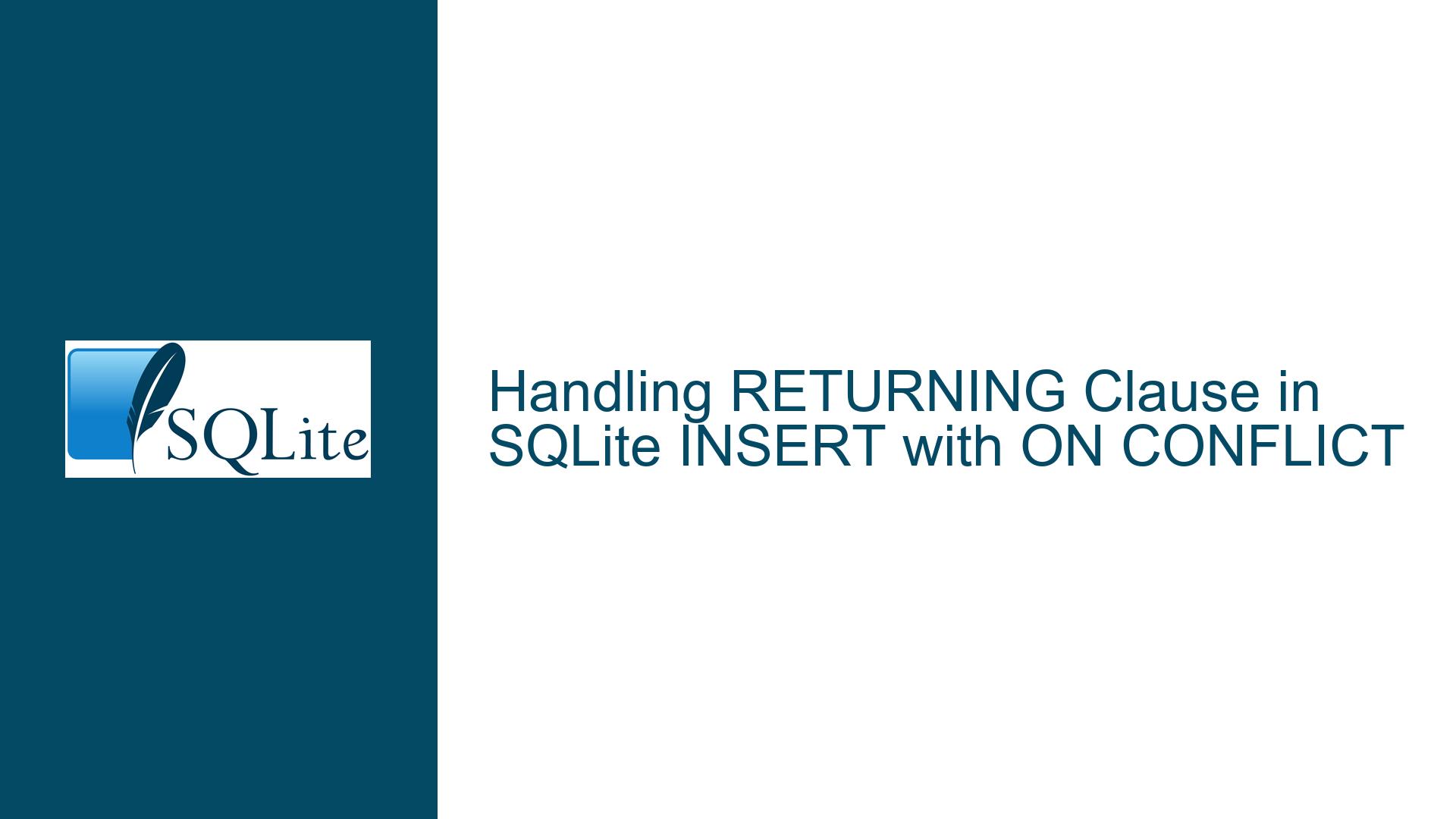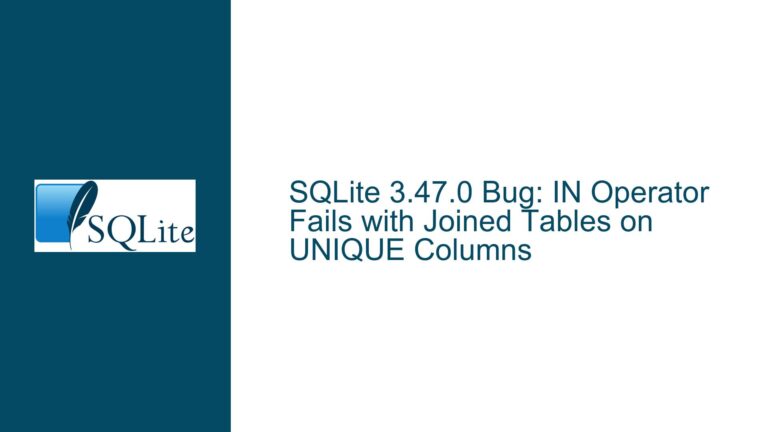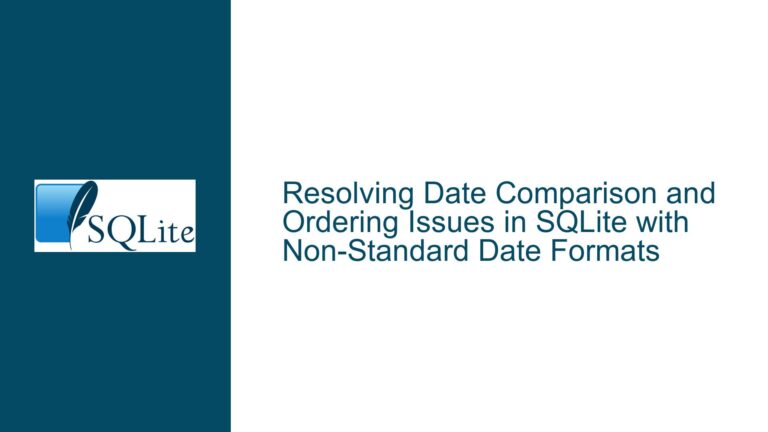Handling RETURNING Clause in SQLite INSERT with ON CONFLICT
Understanding RETURNING Clause Behavior in INSERT with ON CONFLICT
The RETURNING clause in SQLite is a powerful feature that allows developers to retrieve the results of an INSERT, UPDATE, or DELETE operation directly within the same statement. This can be particularly useful when you need to immediately access the rowid or other columns of the newly inserted or modified rows. However, when combined with the ON CONFLICT clause, the behavior of the RETURNING clause can become ambiguous, especially when dealing with conflicts that prevent the insertion of new rows.
In SQLite, the ON CONFLICT clause is used to specify how the database should handle conflicts that arise when attempting to insert a row that violates a unique constraint. The DO NOTHING action, for example, instructs SQLite to silently skip the insertion if a conflict occurs. When the RETURNING clause is used in conjunction with ON CONFLICT DO NOTHING, the question arises: should the RETURNING clause return the rowid of the existing row that caused the conflict, or should it return nothing at all?
The current behavior in SQLite is that the RETURNING clause does not return any rows if the INSERT operation is skipped due to a conflict. This behavior is consistent with the idea that no modification was made to the database, and therefore, there is nothing to return. However, this can be problematic in scenarios where you need to know the rowid of the existing row that caused the conflict, as it forces you to perform additional queries to retrieve this information.
Implications of Silent Conflict Resolution on Data Integrity
The silent nature of the ON CONFLICT DO NOTHING clause can have significant implications for data integrity and application logic. When a conflict occurs and the insertion is skipped, the application may be left unaware of the conflict unless it explicitly checks for it. This can lead to situations where the application assumes that the insertion was successful, even though it was not, potentially causing inconsistencies in the data.
For example, consider a scenario where you are inserting a list of items into a table with a unique constraint on a column. If one of the items in the list conflicts with an existing row, the ON CONFLICT DO NOTHING clause will silently skip the insertion of that item. If the application is not designed to handle this situation, it may proceed under the assumption that all items were successfully inserted, leading to data inconsistencies.
Moreover, the lack of feedback from the RETURNING clause in the event of a conflict can make it difficult to implement certain business logic. For instance, if you need to update a related table with the rowid of the newly inserted row, you would need to first check whether the insertion was successful and then retrieve the rowid of the existing row if it was not. This adds complexity to the application code and increases the risk of errors.
Strategies for Retrieving rowid in Conflict Scenarios
Given the limitations of the RETURNING clause when used with ON CONFLICT DO NOTHING, developers need to adopt alternative strategies to retrieve the rowid of the existing row that caused the conflict. One common approach is to perform a SELECT query before attempting the INSERT to check for the existence of the row. If the row already exists, you can retrieve its rowid directly from the SELECT query. If the row does not exist, you can proceed with the INSERT and use the RETURNING clause to retrieve the rowid of the newly inserted row.
Another approach is to use a Common Table Expression (CTE) to combine the INSERT and SELECT operations into a single query. This can be particularly useful when you need to handle multiple rows in a batch operation. The CTE allows you to first attempt the INSERT and then retrieve the rowid of the existing row if the insertion was skipped due to a conflict. This approach can help reduce the complexity of the application code and improve performance by minimizing the number of queries executed.
For example, consider the following CTE-based approach:
WITH cte AS (
INSERT OR IGNORE INTO my_table(foo) VALUES (?)
RETURNING rowid
)
SELECT rowid FROM cte
UNION ALL
SELECT rowid FROM my_table WHERE foo = ?;
In this query, the INSERT OR IGNORE statement attempts to insert a new row into my_table. If the insertion is successful, the RETURNING clause retrieves the rowid of the newly inserted row. If the insertion is skipped due to a conflict, the SELECT statement retrieves the rowid of the existing row that caused the conflict. The UNION ALL operator combines the results of the INSERT and SELECT operations, ensuring that you always get the rowid of the relevant row, whether it was newly inserted or already existed.
Optimizing Write Operations with Conditional Updates
In some cases, you may want to optimize your write operations by avoiding unnecessary updates when the new value is the same as the existing value. SQLite does not automatically optimize for this scenario, so you need to implement this logic in your application code. One way to do this is to perform a SELECT query to retrieve the current value of the row before attempting the UPDATE. If the new value is the same as the existing value, you can skip the UPDATE operation altogether.
However, this approach can be inefficient if you are dealing with a large number of rows, as it requires an additional query for each row. A more efficient approach is to use the INSERT OR REPLACE statement, which automatically replaces the existing row if a conflict occurs. This can be particularly useful when you want to ensure that the row is always updated with the latest value, regardless of whether the new value is the same as the existing value.
For example, consider the following INSERT OR REPLACE statement:
INSERT OR REPLACE INTO my_table(rowid, foo) VALUES (?, ?);
In this query, the INSERT OR REPLACE statement attempts to insert a new row into my_table. If a conflict occurs, the existing row is replaced with the new row. This approach ensures that the row is always updated with the latest value, without the need for an additional SELECT query.
Implementing PRAGMA journal_mode for Data Consistency
To ensure data consistency in the event of a power failure or other unexpected interruption, it is important to configure SQLite’s journaling mode appropriately. The PRAGMA journal_mode statement allows you to control how SQLite handles transaction rollback and recovery. The most commonly used journaling modes are DELETE, TRUNCATE, PERSIST, and WAL (Write-Ahead Logging).
The DELETE journaling mode is the default mode in SQLite. In this mode, SQLite creates a separate rollback journal file for each transaction. If the transaction is committed successfully, the rollback journal is deleted. If the transaction is rolled back or interrupted, SQLite uses the rollback journal to restore the database to its previous state.
The TRUNCATE journaling mode is similar to the DELETE mode, but instead of deleting the rollback journal file, SQLite truncates it to zero bytes. This can be more efficient on some filesystems, as it avoids the overhead of deleting and recreating the file.
The PERSIST journaling mode is a compromise between the DELETE and TRUNCATE modes. In this mode, SQLite does not delete or truncate the rollback journal file. Instead, it simply marks the journal as invalid by writing a special value to the journal header. This can be more efficient on some filesystems, but it also increases the risk of data corruption if the journal file is not properly cleaned up.
The WAL journaling mode is a more advanced mode that uses a write-ahead log to record changes to the database. In this mode, SQLite writes changes to the WAL file instead of directly modifying the database file. This allows multiple readers to access the database simultaneously, while still ensuring data consistency in the event of a crash.
To set the journaling mode, you can use the following PRAGMA statement:
PRAGMA journal_mode = WAL;
This statement sets the journaling mode to WAL, which is recommended for most applications that require high concurrency and data consistency.
Best Practices for Handling Conflicts and Ensuring Data Integrity
When working with SQLite, it is important to adopt best practices for handling conflicts and ensuring data integrity. One of the most important best practices is to always use transactions to group related operations together. This ensures that either all operations are committed successfully, or none of them are, which helps maintain data consistency.
Another best practice is to use the ON CONFLICT clause to handle conflicts in a way that makes sense for your application. For example, if you want to silently skip conflicting rows, you can use ON CONFLICT DO NOTHING. If you want to replace the existing row with the new row, you can use ON CONFLICT REPLACE. If you want to update specific columns in the existing row, you can use ON CONFLICT DO UPDATE.
It is also important to use the RETURNING clause judiciously, especially when dealing with conflicts. As discussed earlier, the RETURNING clause does not return any rows if the INSERT operation is skipped due to a conflict. Therefore, you should always have a fallback mechanism in place to retrieve the rowid of the existing row if needed.
Finally, it is important to regularly back up your SQLite database to protect against data loss in the event of a crash or other unexpected event. SQLite provides several tools for backing up databases, including the .dump command in the SQLite shell and the sqlite3_backup API in the C interface.
Conclusion
Handling the RETURNING clause in SQLite INSERT statements with ON CONFLICT requires a deep understanding of the database’s behavior and careful consideration of the implications for data integrity and application logic. By adopting best practices such as using transactions, choosing the appropriate conflict resolution strategy, and implementing proper journaling modes, you can ensure that your application handles conflicts gracefully and maintains data consistency. Additionally, by using techniques such as CTEs and conditional updates, you can optimize your write operations and reduce the complexity of your application code. With these strategies in place, you can confidently work with SQLite to build robust and efficient applications.






